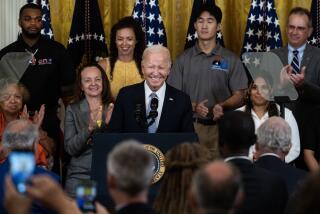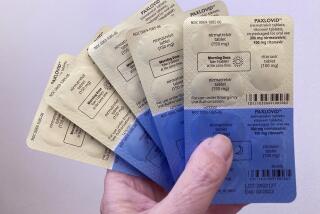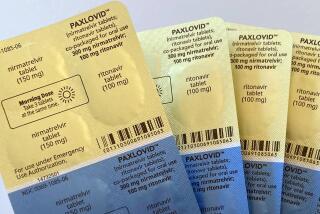Why Big Pharma’s patient-assistance programs are a sham
Pharmaceutical companies are taking a lot of reflected heat in the uproar over the 5,000% price hike for a drug needed by AIDS patients. But so far, the industry’s method of making sure that low-income patients get access to high-priced drugs has avoided the spotlight. That’s too bad because it deserves a lot of scrutiny.
We’re talking about “patient-assistance programs,” through which drugmakers cover patient co-pays or other costs for their expensive medicines. These programs, which are estimated to cover some 300 drugs and cost the industry $4 billion a year — firm figures are carefully guarded by the industry — are detested by insurers, healthcare economists and government agencies. That’s because they’re often marketing schemes dressed up to look like altruism.
These programs are “a triple boon for manufacturers,” David Howard of Emory University wrote last year. “They increase demand, allow companies to charge higher prices, and provide public-relations benefits.” The manufacturers’ costs look high in absolute terms, but the payoff is even greater. “Manufacturers can afford to pay a lot of $25 of $50 co-payments in return for even a small increase in sales of a $50,000 drug,” Howard observed.
Turing Pharmaceuticals, the company under fire for jacking up the price of its toxoplasmosis drug Daraprim from $13.50 to $750 per pill, has implied that a patient-assistance program will cover low-income patients who can’t afford their share of the cost. (Among the prime users of the drug are AIDS patients with damaged immune systems.) Turing’s CEO, Martin Shkreli, told me this weekend that Turing provided half its supply of the drug for free, but because Turing is a private firm, that can’t be verified. In any case, it hasn’t stemmed the uproar.
Drugmakers have been known to use patient-assistance programs to pressure insurers into paying for their expensive drugs. Earlier this year, Gilead Sciences limited its patient-assistance program for its stratospherically priced hepatitis C drugs Sovaldi and Harvoni, in an effort to squeeze insurers. As we reported earlier, the drugs work well, but because they cost nearly $100,000 per treatment, insurers were limiting them to only the sickest hep-C patients.
Gilead hoped that covering patient co-pays would pressure the insurers into allowing broader use of the drugs. When that didn’t happen, the firm shut down assistance for enrollees of insurers that were still applying restrictions; the hope plainly was that patients would scream at the insurers. In effect, the AIDS Healthcare Foundation protested, saying Gilead was “holding hepatitis C patients hostage as a negotiating strategy with health insurers for drugs that they ridiculously overpriced in the first place.”
As that battle shows, private insurers and Medicare officials dislike these programs because subsidizing the patients undermines what may be their most important tool for controlling healthcare costs, which is steering patients to low-cost alternative drugs or generics. The patients are immunized against their small share of the cost, but the insurers and government still have to pick up the rest.
The risk is that patients get hooked on the high-priced product being hawked by the drugmakers despite the availability of cheaper, equally effective options. A 2013 survey of coupon programs, which are related, by Joseph S. Ross of Yale and Aaron S. Kesselheim of Harvard bears out that fear. Typically downloadable from the manufacturers’ websites, the coupons limit or cover the patient’s co-pay for the first purchase of the drug. Of the nearly 400 coupons for brand-name drugs examined by the authors, 62% were for products for which lower-cost alternatives were available.
The programs deliver short-term savings for patients but lock in higher long-term costs for the system, Ross and Kesselheim observed. By the time the patient discount ends, “patients may have developed loyalty to the particular brand or may be skeptical about switching away from a medication that they perceive as effective.”
To combat that outcome, Medicare prohibits patient-assistance programs directly affiliated with a drug manufacturer from covering patient co-pays. The Dept. of Health and Human Services has even warned that manufacturer subsidies to Medicare or Medicaid patients may run afoul of federal anti-kickback laws, which bar payments made to induce patients to choose particular services.
The government allows “bona fide” charities to provide assistance to low-income patients, but even some of those have turned out to have problems. The Chronic Disease Fund, a major charity in the field, was accused in 2013 of having too cozy a relationship with Questcor, the maker of a multiple sclerosis drug sold for $28,000 per vial, which was covered with CDF assistance. (The head of the charity stepped down after the relationship became public.)
The suspect nature of these programs doesn’t solve the problem of how to get the drugs to patients who can’t afford their share. But that’s not an insurmountable problem. For one thing, insurers don’t object so much to assistance programs for drugs that truly are uniquely effective, and at prices that are rational; their big problem is with expensive brand names that are just as effective as alternative treatments, or even inferior.
But it’s more important to impose policies that drive all prescription costs down. Democratic presidential candidates Hillary Clinton and Bernie Sanders both have proposed such programs. Clinton’s, announced this week, would place a cap on patient co-pays of $250 a month and allow the importation of drugs from overseas, where they’re often much less expensive than the U.S. list price.
More effectively, she would allow Medicare to negotiate with drugmakers for lower prices, which Congress prohibited with the passage in 2003 of the Medicare prescription drug program, Part D.
There’s reason to doubt that this change would do enough to drive prices down. That’s because Part D is required to offer patients a broad choice of drugs, which would limit Medicare’s bargaining power. Health economist Austin Frakt has proposed one more wrinkle: Tie Medicare’s required drug list to that of the Veterans Administration. The VA can negotiate with drugmakers and also can be more discriminating about the drugs it provides to patients.
The VA has used this authority to exclude many of the me-too drugs that drive healthcare costs higher. Frakt calculated in 2011 that the VA paid 40% less for drugs than Medicare, while covering 59% of the most popular 200 drugs, compared with Medicare’s 85%. The change, he estimated, could save Medicare more than $14 billion a year. It might have a considerable multiplier effect nationwide by providing a truly effective benchmark for drug prices.
There’s no doubt that it would have a much greater effect than the self-interested patient-assistance programs that cut prices for the few while keeping them bloated for everyone else. Drug companies shouldn’t be permitted to hide their fattening profits behind the shroud of philanthropy. That just costs everyone real money.
Keep up to date with the Economy Hub. Follow @hiltzikm on Twitter, see our Facebook page, or email michael.hiltzik@latimes.com.







